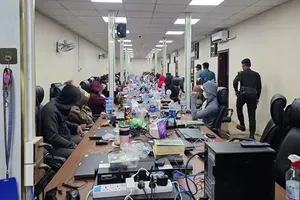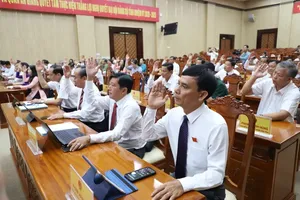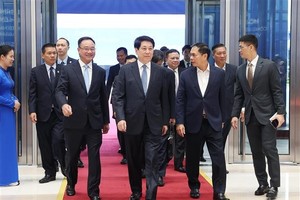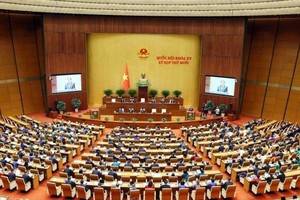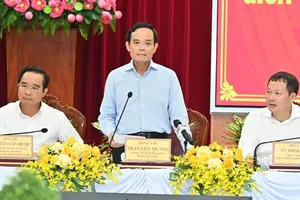
Prime Minister Pham Minh Chinh delivered a report supplementing the assessment of the implementation of the 2024 socio-economic development and State budget plans, as well as the progress made in the early months of 2025 at the opening session of the 9th meeting of the 15th National Assembly on the morning of May 5.
Presenting the updated evaluation of the 2024 socio-economic development plan, the Prime Minister emphasized that compared to the report presented at the 8th session, the updated data and information paint a more positive picture. Notably, all 15 out of 15 socio-economic targets were either met or exceeded, an improvement over the previous report which had recorded success in 14 out of 15 indicators. GDP growth reached 7.09 percent—surpassing the earlier estimated range of 6.8 percent to 7 percent—making it the highest in the region and placing Vietnam among the world’s fastest-growing economies. The country’s GDP rose to $476.3 billion, elevating its global economic ranking by three places to 32nd.

The Prime Minister noted that since the beginning of the year, the global landscape has become increasingly complex and unpredictable, particularly following the US decision to impose high reciprocal tariffs, which were later postponed for 90 days for most trading partners (excluding China). A provisional tariff rate of 10 percent has been set. These developments pose significant risks to global economic growth, threatening supply chains and disrupting international trade and investment flows.
In this challenging context, under the guidance of the Central Committee, the National Assembly, and the directions of General Secretary To Lam, and with a spirit of discipline, accountability, proactiveness, efficiency, and a drive for breakthrough progress, the Government has directed ministries, agencies, and local authorities to implement tasks and solutions in a coordinated, determined, and effective manner. These include streamlining the administrative apparatus to ensure seamless operations, reorganizing administrative units across all levels, establishing a two-tier local government model, focusing on achieving growth of at least 8 percent, and reforming the legislative and law enforcement processes.

According to the Prime Minister, in response to the US announcement of its new tariff policy, Vietnam remained composed and decisive, proactively implementing a range of timely, coordinated, and flexible countermeasures that were appropriate to the situation and yielded initial positive outcomes. Vietnam has emerged as one of the first countries the US has agreed to enter negotiations with, which are scheduled to begin on May 7.
According to the report, GDP growth in the first quarter of 2025 is estimated at 6.93 percent, the highest rate for the same period between 2020 and 2025, with several localities recording double-digit growth. All three economic sectors posted strong performance, and infrastructure continued to develop modernly and synchronously, with a clear focus on key national projects.
The Prime Minister emphasized that to achieve a growth rate of 8 percent or higher—with the economy projected to exceed $500 billion, potentially rising to 30th place globally, and per capita GDP surpassing $5,000 in 2025—all levels of government, agencies, and localities must continue to implement the proposed tasks and solutions with determination, consistency, and effectiveness across all areas. Crucially, this requires institutionalizing and translating the Politburo’s resolutions into concrete actions, executing them decisively and efficiently; advancing comprehensive reforms in state governance; and refining the political system’s organizational structure with a firm commitment to thorough, uncompromising implementation.
He emphasized the need to continue streamlining and improving the political system’s organizational structure in 2025 and throughout the 2025–2030 term, in line with the timeline and progress set for restructuring administrative units at all levels and building a two-tier local government model.
The Prime Minister also underscored the requirements to proactively review and either issue legal documents within authorized jurisdiction or submit them to competent authorities for amendment, supplementation, or promulgation, in alignment with the effective date of the amended 2013 Constitution, expected on July 1, 2025. This is to ensure the uninterrupted and seamless functioning of the two-tier local government model—at the provincial and communal levels—without creating any legal void once district-level government structures are no longer in place. He emphasized the importance of timely guidance and implementation of the restructuring and consolidation of provincial-level administrative units, the reorganization of commune-level units, and the establishment of two-tier local governments, in accordance with the timeline set by the Politburo, the Central Steering Committee, the Government, and the Prime Minister.

He called for careful attention to political and ideological work, as well as policies for officials affected by restructuring. Personnel decisions must be made objectively and fairly, with the principle of "choosing the right person for the task," retaining capable staff to prevent brain drain and avoiding internal disruptions. There should be policies to attract talent into public service and special incentives for civil servants with outstanding achievements. At the same time, a mechanism must be in place to remove those lacking competence or integrity, and clearer support must be given to those who dare to think and dare to act.
